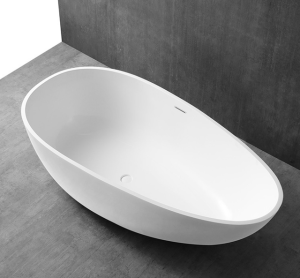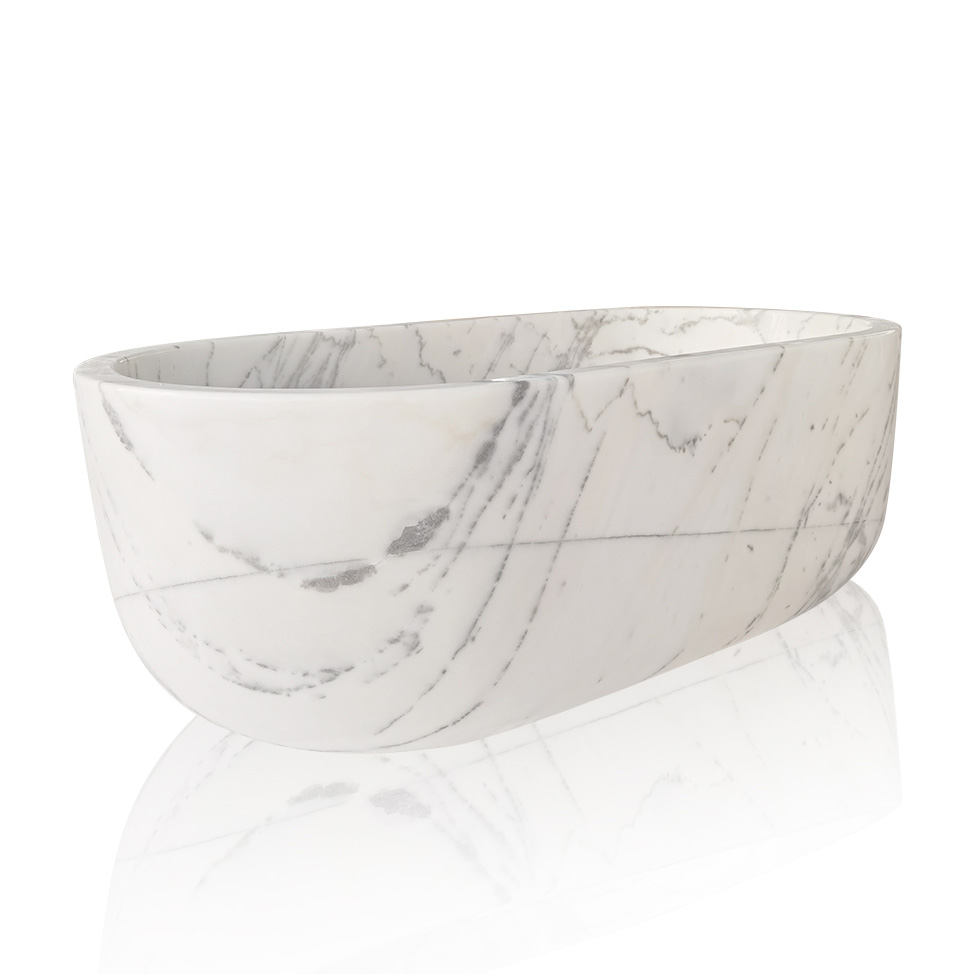Spas have always been an ideal place for urbanites to escape stress and relax. Among all the ways to relax, bathing is undoubtedly the most classic way. Still, spas provide a wide range of bathtubs. More and more luxury spas have lately started to choose natural stone bathtubs. What difference can this bathing appliance given by nature bring to the spa experience? Today, let’s explore the utilization efficiency of natural stone bathtubs in spas and see if it is worth the high price.

Natural stone bathtubs enhance the customer experience
The charm and characteristics of natural stone bathtubs
1. The unique touch and visual enjoyment of natural stone
Natural stone bathtubs are carved from naturally formed stones. Sandstone, granite and marble are the most often used materials. Its main characteristic is the pure natural texture: delicate but smooth, yet thick and strong, which helps people to feel like they are going back to nature. Imagine that when you lie in a bathtub carved from billions of years of stone, the surrounding textures and tones are unique, as if integrated with nature, and the whole person’s mood will relax.
This visual and tactile enjoyment is one of the reasons why many high-end spas choose natural stone bathtubs. The noble texture of genuine stone gives the whole spa experience much more luxury than standard acrylic or ceramic bathtubs, which draws many clients seeking the best possible experience.
2. Natural heat preservation: longer comfort
Warm water bath is an important part of the spa experience, and maintaining water temperature is a crucial factor. Because of its great density, natural stone preserves heat rather well. It can slowly absorb heat from the water and keep the water temperature constant for a long time, which means that customers can enjoy a warm bath for a longer time without frequently heating the water.
For spas, this not only improves the customer experience, but also reduces the energy consumption of frequent water heating to a certain extent. One may say that natural stone bathtubs are a wise and ecologically beneficial option.
3. Health and healing effects
Natural stones are not just a decoration, they also have certain health and healing effects. Ancient people thought stones possessed special energy capable of relaxing the body, cleansing and revitalizing it. Although modern science may not be able to fully prove this statement, it is undeniable that natural stone can bring a sense of psychological peace.
For example, the smooth texture and cool touch of a marble bathtub can help relieve muscle tension, while the solid texture and warm feel of a granite bathtub can bring people a sense of security. This combination psychological and bodily comfort is a special and quite soothing experience for those looking for leisure in their hectic job.

Natural stone bathtubs have high density and excellent thermal insulation
Challenges and considerations of natural stone bathtubs
1. Weight and installation challenges
Natural stone is somewhat weighty even if it is beautiful and strong. An ordinary marble bathtub may weigh hundreds of kilograms and is very complicated to install. Usually, it means strengthening the floor construction; even some buildings could not be able to support such weight.
For spas, when choosing a natural stone bathtub, it is necessary to consider the complexity and cost of installation. The floor’s load-bearing capacity must be carefully assessed, and bathtub transportation calls for more planning. These issues undoubtedly increase the cost of the spa, but for those places that pursue high-end services, the unique experience brought by the natural stone bathtub is often worth it.
2. Care and maintenance costs
The porous nature of natural stone makes it more likely to absorb moisture and stains, especially in a spa environment with high humidity. Natural stone bathtubs so require consistent sealing and maintenance to stop water stains and dirt from seeping into the stone, hence generating discolouration or bacterial growth.
Although this maintenance process is not complicated, the maintenance cost of natural stone bathtubs is obviously higher than that of ordinary materials. To keep natural stone baths beautiful and hygienic, spas have to commit more time and money.
3. Environmental protection and resource consumption
Although natural stone comes from nature, the impact of its mining process on the environment cannot be ignored. Usually involving large-scale mechanical operations, mining natural stone could harm the ecological surroundings. Concurrent with this, moving and handling these stones requires a lot of energy.
For spas that focus on sustainability and environmental protection, using natural stone bathtubs may bring certain ethical dilemmas. Choosing recycled stone bathtubs or sustainable mining certified stone, however, can help to somewhat lower this environmental impact.
The actual application efficiency of natural stone bathtubs in spas
1. Shaping a high-end brand image
The high cost and luxurious texture of natural stone bathtubs are the perfect tool for spas to create a mature and elegant atmosphere. By using a natural stone bathtub, the grade of the spa can be improved directly and draw clients ready to pay for an unusual experience. For those customers who are looking for a double relaxation of body and mind, a natural stone bathtub is undoubtedly a huge plus.
2. Improved customer satisfaction
Many spa customers are looking for a deep relaxation from head to toe, and the texture, thermal insulation and healing effect of a natural stone bathtub can greatly enhance customer satisfaction. Those who have loved a natural stone bathtub spa could recall this unusual feature and start visiting often. Through this high-quality service experience, spas can better retain customers and win word-of-mouth effect.
3. Long-term cost trade-off
Although natural stone bathtubs have a higher initial cost and relatively high maintenance costs, their durability means that these investments will eventually pay off in the long run. Natural stone bathtubs have a long service life and are almost free of common wear and damage problems, which can reduce the frequency of equipment replacement in the long run.
In addition, due to the better thermal insulation of natural stone, spas can also consume relatively less energy to maintain water temperature, which to some extent alleviates the cost pressure of long-term operation.

Natural stone bathtubs are beautiful and durable
In general, natural stone bathtubs are highly efficient in spas, especially for those seeking high-end quality and deep relaxation. Though it is heavy and costly to install and maintain, its special beauty, soft touch, and great thermal insulation will surely improve the whole experience and gratification of consumers. When choosing whether to use a natural stone bathtub, spas need to consider their own positioning, customer needs and long-term operating costs, but for the high-end market, it is undoubtedly a worthwhile investment.
Frequently Asked Question (FAQ)
How to install a marble bathtub?
Installing a marble bathtub requires careful planning and attention to detail. First, choose the right location for the bathtub, ensuring it has a strong structure and is not too heavy. Ensure the floor is flat to prevent instability and leaks. Move the bathtub with help, preferably a professional, to avoid damage. Install the drainage system, ensuring a complete seal and a professional plumber for any plumbing knowledge. Test the water flow and drainage system, ensuring smooth water flow and stability. Seal the bathtub with a waterproof sealant to prevent leaks and ensure long-term use. Install the faucet and shower, ensuring a tight and seamless interface. Add decorative elements like scented candles, soft bath towels, and green plants for a warm and comfortable bathroom. Consider accessories like anti-slip mats and bathtub pillows for added comfort. Although installing a marble bathtub may be time-consuming, the luxurious experience it brings is worth it.





